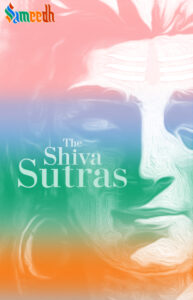The Shiv Sutras are a set of aphorisms that form the foundation of the Shaiva Siddhanta philosophy, a major school of Shaivism. These sutras are attributed to the sage Vasugupta and are believed to have been revealed to him by Lord Shiv himself.

The Shiv Sutras are considered one of the fundamental texts in Kashmir Shaivism, which is a branch of Shaivism that flourished in the Kashmir region of India. The Shiva Sutras consist of 77 aphorisms (sutras) divided into three sections:
- Vidya Pada (Section on Knowledge): This section consists of 16 sutras and deals with the nature of reality, the relationship between the individual soul (jiva) and the supreme consciousness (Shiv), and the process of liberation (moksh).The Vidya Pada contains the initial aphorisms (sutras) of the Shiv Sutras, which lay the foundation for understanding the nature of reality, consciousness, and the path to spiritual liberation. These sutras introduce key concepts and principles that are essential for practitioners of Kashmir Shaivism:
- Recognition of the Self: The Vidya Pada begins by asserting the ultimate reality of the self (atman) as identical with the supreme consciousness (Shiv). It emphasizes the importance of recognizing one’s true nature as divine and transcending the limitations of the individual ego.
- Non-Dualistic Philosophy: The sutras of the Vidya Pada expound upon the non-dualistic philosophy of Kashmir Shaivism, which asserts the unity of the individual soul (jiva) and the universal consciousness (Shiv). They affirm that the essence of the self is pure consciousness, unbounded by time, space, or limitations.
- Nature of Reality: The Vidya Pada discusses the nature of reality as the play of consciousness (spanda) and asserts that all phenomena arise from, abide in, and dissolve back into the supreme consciousness. It elucidates how the entire universe is an expression of divine creativity.
- Path to Liberation: These sutras outline the path to spiritual liberation (moksh) in Kashmir Shaivism, which involves recognizing one’s true identity with the supreme consciousness and experiencing the bliss of union (yoga) with Shiv. They emphasize the importance of self-realization and the awakening of spiritual consciousness.
- Kriya Pada (Section on Practice): This section comprises 33 sutras and focuses on the practices of yoga, meditation, and ritual worship as means to realize one’s true nature and attain spiritual enlightenment.In the Kriya Pada, the aphorisms (sutras) provide guidance on how to apply the philosophical principles introduced in the Vidya Pada (Section on Knowledge) into practical sadhana (spiritual practice). Here are some key aspects covered in the Kriya Pada:
- Yoga and Meditation Techniques: The Kriya Pada introduces different methods of yoga and meditation aimed at realizing the non-dual nature of consciousness. These may include practices such as breath control (pranayam), concentration (dharan), meditation (dhyan), and contemplation (nididhyasan).
- Mantra Recitation: The use of mantra (sacred sound) as a powerful tool for spiritual transformation is emphasized in the Kriya Pada. Practitioners are instructed on the selection, pronunciation, and repetition of specific mantras to awaken higher states of consciousness and dissolve the ego.
- Ritual Worship: The Kriya Pada may also include instructions on ritual worship (puja) and ceremonial practices aimed at invoking divine grace and purifying the mind and body. Rituals may involve offerings, prayers, and visualizations to connect with the divine.
- Inner Awakening: The sutras in this section guide practitioners towards inner awakening and self-realization. They may provide insights into the nature of the mind, the process of spiritual evolution, and the dissolution of egoic identifications.
- Integration of Practice with Daily Life: The Kriya Pada emphasizes the importance of integrating spiritual practice into daily life. It encourages practitioners to cultivate mindfulness, compassion, and awareness in all activities, thereby deepening their spiritual journey.
- Shakti Pada (Section on Power): This section contains 28 sutras and elaborates on the concept of Shakti, the divine energy or power that pervades the universe. It explores the various manifestations of Shakti and its role in the process of creation, preservation, and dissolution. In the Shakti Pada, the aphorisms (sutras) provide insights into the dynamic and creative aspect of consciousness, represented by Shakti. Here are some key aspects covered in the Shakti Pada:
- Nature of Shakti: The sutras elucidate the nature of Shakti as the primordial energy that pulsates with the power of creation, preservation, and dissolution. Shakti is portrayed as the dynamic force that animates all phenomena and sustains the universe.
- Creative Manifestation: The Shakti Pada discusses how Shakti manifests in various forms and phenomena, ranging from subtle energy vibrations to gross material manifestations. It explores the diverse expressions of Shakti’s power in the cosmos.
- Spanda (Vibration): The sutras may elaborate on the concept of Spanda, the pulsation or vibration of divine consciousness. Shakti is intimately connected with Spanda, as it represents the dynamic movement of consciousness within itself, giving rise to the universe.
- Tattvas (Principles): The Shakti Pada may also discuss the Tattvas, the fundamental principles or categories of existence according to Kashmir Shaivism. Shakti is considered the primary Tattva, from which all other Tattvas emerge.
- Liberation through Shakti: The sutras in this section may reveal how practitioners can harness the power of Shakti to attain spiritual liberation (moksh). By recognizing and aligning with Shakti’s energy, individuals can transcend limitations and merge with the supreme consciousness (Shiv).
- Devotional Practices: The Shakti Pada may include teachings on devotional practices (bhakti) directed towards Shakti, such as chanting hymns, reciting mantras, and performing rituals to invoke her grace and blessings.
The Shiv Sutras are highly revered for their concise yet profound insights into the nature of reality and the path to spiritual liberation. They are often studied and commented upon by scholars and practitioners of Kashmir Shaivism, as well as other schools of Shaivism and Hindu philosophy.
The Shiv Sutras have been translated into various languages, and numerous commentaries have been written to elucidate their meanings and significance. They continue to inspire seekers on the spiritual path with their timeless wisdom and profound teachings.